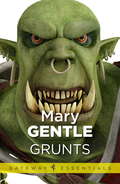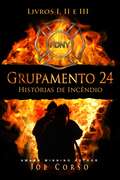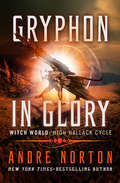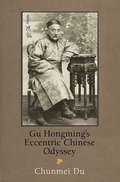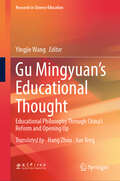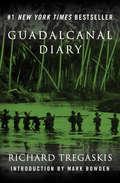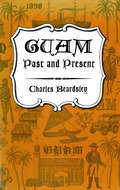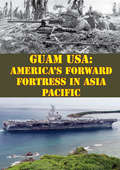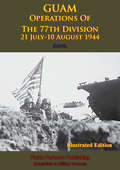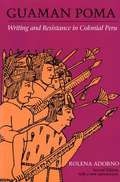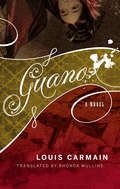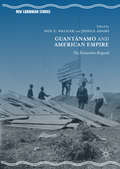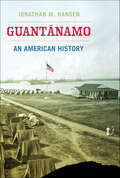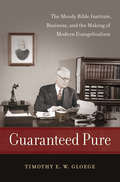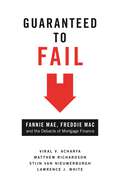- Table View
- List View
Grunts (Gateway Essentials #416)
by Mary GentleWhat is an orc?An orc is an 18 stone fighting machine, made of muscle, hide, talon and tusk, with a villainous disposition and a mean sense of humour. And, of course, an orc is a poor dumb grunt - the much abused foot soldier of the Evil Horde of Darkness.The usual last battle of Good against Evil is about to begin. Orc Captain Ashnak and his war-band know exactly what they can expect. The forces of Light are outnumbered, full of headstrong heroes devoid of tactics - but the Light's still going to win. Orcs - the sword fodder in the front line - will die by the thousands.Life's a bitch.
Grunts: The American Combat Soldier in Vietnam
by Kyle Longley Jacqueline WhittNow in its second edition, Grunts: The American Combat Soldier in Vietnam provides a fresh approach to understanding the American combat soldier’s experience in Vietnam by focusing on the day-to-day experiences of front-line troops. The book delves into the Vietnam combat soldier’s experience, from the decision to join the army, life in training and combat, and readjusting to civilian life with memories of war. By utilizing letters, oral histories, and memoirs of actual veterans, Kyle Longley and Jacqueline Whitt offer a powerful insight into the minds and lives of the 870,000 "grunts" who endured the controversial war. Important topics such as class, race, and gender are examined, enabling students to better analyze the social dynamics during this divisive period of American history. In addition to an updated introduction and epilogue, the new edition includes expanded sections on military chaplains, medics, and the moral injury of war. A new timeline provides details of major events leading up to, during, and after the war. A truly comprehensive picture of the Vietnam experience for soldiers, this volume is a valuable and unique addition to military history courses and classes on the Vietnam War and 1960s America.
Grunts: The American Combat Soldier in Vietnam
by Kyle LongleyThis book provides a fresh approach to understanding the American combat soldier's experience in Vietnam. It integrates such topics as the political culture, the experiences of training, the actual Vietnam experience, and the 'homecoming', and offers a remarkable overview of the 870,000 'grunts' who bore the brunt of the fighting in the jungles and highlands of South Vietnam, and eventually Cambodia and Laos.The book addresses many of the stereotypes of the Vietnam combat veteran that have been perpertrated in popular culture, and also considers how Vietnam veterans have been commemorated through memorials and other means, and how the veterans remember each other. The coverage also includes women who served in or near the front lines as well as on the home front. The author draws on memoirs and oral histories including his personal interviews with veterans, but the book conveys a picture of the Vietnam combat soldier's experience far more powerful than what individual memoirs can provide.
Grupamento 24: Histórias de Incêndio - Livros I, II e III
by Joe Corso Raimundo Alves dos SantosGrupamento 24: Histórias de incêndio - Livros I, II e III de Joe Corso Histórias verdadeiras do Corpo de Bombeiros de Nova York que aconteceram entre 1963 e 1975. Agora, tudo em um único livro, Grupamento 24 por Joe Corso: As Histórias de Incêndio - Livros I, II, e III, incluindo as premiadas histórias de incêndio: Garagem 598! Grupamento 24: Histórias de incêndio - Livros I, II e III narram a carreira de Joe D' Albert, autor conhecido como Joe Corso, quando era bombeiro da cidade de Nova York. Nesta compilação emocionante de histórias de incêndio, Corso detalha os triunfos e as tragédias de seus camaradas de armas enquanto combatem bravamente alguns dos incêndios mais perigosos na história da cidade. Ele fala de heróis reais e das amizades para a toda vida que fez, bem como alguns dos tumultos que existiam na cidade de Nova York durante o tempo em que servia no departamento. Siga Corso pelos anos 1960 e 1970 até os dias de hoje, dos conflitos raciais ao 11 de setembro, quando as chamas reais da instabilidade foram extinguidas pelas pessoas mais bravas na história americana recente. Gênero: História / Historiografia Gênero Secundário: História / Referência Idioma: Português Palavras chave Número de palavras: 47.111 Informações de venda: Quando eu era um bombeiro, às vezes fazia anotações sobre os incêndios que combatia. Este livro é uma compilação dessas anotações. Um trailer deste livro pode ser visto no Youtube: Acesse o link: https://www.youtube.com/watch?v=7COvCUgW8uE
Gryphon in Glory (Witch World: High Hallack Cycle #4)
by Andre NortonThe epic saga begun in The Crystal Gryphon continues in the Witch World as the destiny of two embattled lovers may decide the fate of all . . . Kerovan of Ulmsdale released his wife, Joisan, of all obligations to him. Though their love is unbreakable, he could not burden her with his unrest as he was beckoned to wander the Waste in search of his true destiny. But Joisan, unable to bear his absence, leaves her refuge to find him. And with both of them gone, the Dales are sure to fall under the power of the Dark as the shadows of evil begin to rise across the land. Even when they are reunited in the Waste, Kerovan cannot open his heart to his beloved. Not as long as the mystery of his lineage remains. Undaunted and guided by the powerful crystal gryphon given to her by Kerovan, Joisan refuses to leave his side. For it will take both of their great wills to confront the horrors of the coming Darkness. Nominated for a Locus Award, this fantastical novel by the Science Fiction Writers of America Grand Master Andre Norton explores the Witch World land of High Hallack. Gryphon in Glory is the 4th book in the Witch World: High Hallack Cycle, but you may enjoy reading the series in any order.
Gryphon in Glory: The Jargoon Pard, Zarsthor's Bane, The Crystal Gryphon, Gryphon In Glory, And Horn Crown (Witch World: High Hallack Cycle #6)
by Andre NortonThe epic saga begun in The Crystal Gryphon continues in the Witch World as the destiny of two embattled lovers may decide the fate of all . . . Kerovan of Ulmsdale released his wife, Joisan, of all obligations to him. Though their love is unbreakable, he could not burden her with his unrest as he was beckoned to wander the Waste in search of his true destiny. But Joisan, unable to bear his absence, leaves her refuge to find him. And with both of them gone, the Dales are sure to fall under the power of the Dark as the shadows of evil begin to rise across the land. Even when they are reunited in the Waste, Kerovan cannot open his heart to his beloved. Not as long as the mystery of his lineage remains. Undaunted and guided by the powerful crystal gryphon given to her by Kerovan, Joisan refuses to leave his side. For it will take both of their great wills to confront the horrors of the coming Darkness. Nominated for a Locus Award, this fantastical novel by the Science Fiction Writers of America Grand Master Andre Norton explores the Witch World land of High Hallack. Gryphon in Glory is the 4th book in the Witch World: High Hallack Cycle, but you may enjoy reading the series in any order.
Grétry's Operas and the French Public: From the Old Regime to the Restoration (Ashgate Interdisciplinary Studies in Opera)
by R.J. ArnoldWhy, in the dying days of the Napoleonic Empire, did half of Paris turn out for the funeral of a composer? The death of André Ernest Modeste Grétry in 1813 was one of the sensations of the age, setting off months of tear-stained commemorations, reminiscences and revivals of his work. To understand this singular event, this interdisciplinary study looks back to Grétry’s earliest encounters with the French public during the 1760s and 1770s, seeking the roots of his reputation in the reactions of his listeners. The result is not simply an exploration of the relationship between a musician and his audiences, but of developments in musical thought and discursive culture, and of the formation of public opinion over a period of intense social and political change. The core of Grétry’s appeal was his mastery of song. Distinctive, direct and memorable, his melodies were exported out of the opera house into every corner of French life, serving as folkloristic tokens of celebration and solidarity, longing and regret. Grétry’s attention to the subjectivity of his audiences had a profound effect on operatic culture, forging a new sense of democratic collaboration between composer and listener. This study provides a reassessment of Grétry’s work and musical thought, positioning him as a major figure who linked the culture of feeling and the culture of reason - and who paved the way for Romantic notions of spectatorial absorption and the power of music.
Gu Hongming's Eccentric Chinese Odyssey (Encounters with Asia)
by Chunmei DuKnown for his ultraconservatism and eccentricity, Gu Hongming (1857-1928) remains one of the most controversial figures in modern Chinese intellectual history. A former member of the colonial elite from Penang who was educated in Europe, Gu, in his late twenties, became a Qing loyalist and Confucian spokesman who also defended concubinage, footbinding, and the queue. Seen as a reactionary by his Chinese contemporaries, Gu nevertheless gained fame as an Eastern prophet following the carnage of World War I, often paired with Rabindranath Tagore and Leo Tolstoy by Western and Japanese intellectuals.Rather than resort to the typical conception of Gu as an inscrutable eccentric, Chunmei Du argues that Gu was a trickster-sage figure who fought modern Western civilization in a time dominated by industrial power, utilitarian values, and imperialist expansion. A shape-shifter, Gu was by turns a lampooning jester, defying modern political and economic systems and, at other times, an avenging cultural hero who denounced colonial ideologies with formidable intellect, symbolic performances, and calculated pranks. A cultural amphibian, Gu transformed from an "imitation Western man" to "a Chinaman again," and reinterpreted, performed, and embodied "authentic Chineseness" in a time when China itself was adopting the new identity of a modern nation-state.Gu Hongming's Eccentric Chinese Odyssey is the first comprehensive study in English of Gu Hongming, both the private individual and the public cultural figure. It examines the controversial scholar's intellectual and psychological journeys across geographical, national, and cultural boundaries in new global contexts. In addition to complicating existing studies of Chinese conservatism and global discussions on civilization around the World War I era, the book sheds new light on the contested notion of authenticity within the Chinese diaspora and the psychological impact of colonialism.
Gu Mingyuan’s Educational Thought: Educational Philosophy Through China’s Reform and Opening Up (Research in Chinese Education)
by Yingjie WangThis book systematically reviews the educational thought of Mr. Gu Mingyuan, one of the most prestigious educationists in contemporary China, and details the development of his pioneering educational ideas. The content covers virtually all areas of education, from pre-school to higher education and lifelong learning, from general education to vocational education and informal learning. In the process, it comprehensively reflects Mr. Gu’s insights on global education and his perspectives on Chinese education, reviews China’s educational history, assesses the status quo, and outlines the future of education. Since he has not only been a significant witness but also a key promoter of all major educational changes since China’s reform and opening up over the past 40 years, this book is more than a personal biography of a Chinese educationist; rather, it epitomizes the evolution of China’s educational thinking over the past four decades.
Guadalcanal 1942-43
by Peter Dennis Mark StilleThe Guadalcanal campaign began with an amphibious assault in August 1942 - the US's first attempt to take the fight to the Japanese. It quickly escalated into a desperate attritional battle on land, air and sea, and by the time the Japanese had evacuated the last of their forces from the island in 1943, it was clear that the tide of the war had turned. The previously inexorable Japanese advance had been halted, and the myth of Japanese invincibility shattered. The fighting brought into sharp relief several crucial weaknesses of Japanese strategic planning and war economy, while the US was able to hone its Marine forces into the finest of points - ready for the devastating island-hopping campaign that would bring the war to Japan's doorstep. In this new study of the campaign, Pacific War expert Mark Stille draws on both US and Japanese sources to give a balanced and comprehensive account of a crucial, brutal conflict. Analyzing the three Japanese attempts to retake the island in the face of ferocious, and ultimately successful, American resistance, this book shows how the battle was won and lost, and how it would affect the outcome of the Pacific War as a whole.
Guadalcanal Diary
by Richard TregaskisThe battle for Guadalcanal and the Solomon Islands, an important turning point of the war in the Pacific, is now recognized as one of the most vital campaigns in all our history. Richard Tregaskis, a war correspondent for International News Service during World War II, was with the marines when they landed on the Japanese-held island of Guadalcanal in the summer of 1942. <P> For seven crucial weeks he ate, slept, and sweated with our front-line units. He also kept a diary, in which he described the island's occupation by our forces and their magnificent defense of that seven-mile strip against innumerable attacks by superior air, land and sea forces. This remarkable diary was originally published in 1943, and has since become a classic of World War II reporting. <P> For this shorter, Landmark edition Mr. Tregaskis has written several new chapters to tell how the battle for Guadalcanal fitted into the history of the war in the Pacific. Thus the reader will gain an understanding of why the battle for Guadalcanal ranks in importance with Valley Forge and Gettysburg.
Guadalcanal Diary: Guadalcanal Diary, Invasion Diary, And John F. Kennedy And Pt-109
by Richard Tregaskis#1 New York Times Bestseller: A &“superb&” eyewitness account of one of the bloodiest and most pivotal battles of World War II (Mark Bowden, author of Black Hawk Down). On August 7, 1942, eleven thousand US Marines landed on Tulagi and Guadalcanal Islands in the South Pacific. It was the first major Allied offensive against Japanese forces; the first time in history that a combined air, land, and sea assault had ever been attempted; and, after six months of vicious fighting, a crushing defeat for the Empire of Japan and a major turning point in the Pacific War. Volunteer combat correspondent Richard Tregaskis was one of only two journalists on hand to witness the invasion of Guadalcanal. He risked life and limb to give American readers a soldier&’s experience of the war in the Pacific, from the suffocating heat and humidity to the unique terror of fighting in tall, razor-sharp grass and in crocodile-infested jungle streams against a concealed enemy. In understated yet graceful prose, Tregaskis details the first two months of the campaign and describes the courage and camaraderie of young marines who prepared for battle knowing that one in four of them wouldn&’t make it home. An instant bestseller when it was first published in 1943 and the basis for a popular film of the same name, Guadalcanal Diary set the standard for World War II reportage. Hailed by the New York Times as &“one of the literary events of its time,&” it is a masterpiece of war journalism whose influence can be found in classic works such as John Hersey&’s Hiroshima, Michael Herr&’s Dispatches, and Dexter Filkins&’s The Forever War. This ebook features an illustrated biography of Richard Tregaskis including rare images from the American Heritage Center at the University of Wyoming.
Guam 1941 & 1944
by Howard Gerrard Gordon RottmanThe island of Guam was the first Allied territory lost to the Japanese onslaught in 1941. On 10 December 5,000 Japanese troops landed on Guam, defended by less than 500 US and Guamanian troops, the outcome was beyond doubt. On 21 July 1944 America returned. In a risky operation, the two US landing forces came ashore seven miles apart and it was a week before the beachheads linked up. Only the battles for Iwo Jima and Okinawa would cost the Americans more men than the landings on Guam and Saipan, which immediately preceded the Guam operation. In this book Gordon Rottman details the bitter 26-day struggle for this key Pacific island duringWorld War II (1939-1945).
Guam Past and Present
by Charles BeardsleyThis expansive history of Guam provides a rare look at the people and culture of this tiny, but strategically important Pacific Island.In a highly readable style author Beardsley-himself a sometime resident of Guam-introduces the reader to the island in three stages. Part One, "The Island in Profile," furnishes practical information on the geography, flora, fauna, aboriginal inhabitants, early culture, and legends of Guam.Part Two, "Discovery and Conquest," traces its history from the days of European exploration, beginning with Magellan's discovery of the island in 1521 and continuing down through the Spanish colonial period to the arrival of the Americans in 1898 following Spain's cession of Guam to the United States.Part Three, "Twentieth-Century Guam," is concerned with the island under U.S. administration and, during World War II, Japanese occupation; its recapture in 1944; its reconstruction and progress toward true territorial status; and its present-day position as a vital American outpost in the Western Pacific.Important and informative for resident and visitor alike, this enjoyable and attractively illustrated introduction to Guam also holds interest for the general reader who is susceptible to the lure of colorful events against equally colorful backgrounds.
Guam USA: America's Forward Fortress In Asia Pacific
by Colonel Jerry M. RiveraDuring the final stages of World War II, Japan was finally defeated through the strategic use of the Marianas Islands as a jumping-off point for power projection into the heart of Japan. The main island, Guam, and her northern sister islands, Saipan and Tinian, were the hub from which American forces inched northward towards Japan. Admiral Chester W. Nimitz, USN, believed in the strategic value of the Marianas because he moved his Pacific Ocean Areas headquarters to Guam where he could better direct joint forces operations closer to Japan.Guam, Saipan, and Tinian were used as staging bases from which over 500,000 troops and approximately 1,500 ships were readied for their move on Okinawa. It was from these islands where U.S. B-29's took off for bombing raids on Japanese cities and where the Enola Gay began its mission to drop atomic bombs on Hiroshima and Nagasaki.Like World War II, the U.S. military should withdraw all its foreign bases in the Asia Pacific region and return to Guam and possibly, the Marianas which are United States soil and make it their hub of operations. We can still maintain a strategic forward military presence from Guam and feasibly project our military power deep into Asia to protect America's vital interests in peace and regional stability. We will be near, yet far enough away from Asia to do so.
Guam: Operations Of The 77th Division - 21 July-10 August 1944 [Illustrated Edition]
by AnonIllustrated with 27 maps and 33 IllustrationsTHE INVASION OF THE SOUTHERN MARIANAS in June and July of 1944 was part of a coordinated effort by U. S. forces to gain bases within striking distance by air of the Philippines and the Japanese home islands. The enemy position in the Pacific was weakening under strong Allied offensives, which moved along two lines converging on the Japanese inner zone. From Australia the Allied offensive had developed on an axis northwest along New Guinea and beyond the Bismarck Sea, and from Hawaii it had moved to the west through the Marshall Islands. The advance along both lines had depended upon the conquest of enemy islands selected to form a system of supporting garrisons from which air and sea power could neutralize the remaining enemy bases in the area.The seizure of Guam in July-August 1944 added another base to our growing chain of possessions encircling the Japanese homeland. Marine troops made the initial landings on Guam and were aided in capturing the island by army units, comprised chiefly of the 77th Infantry Division. Guam tells the Army's part of the campaign.
Guaman Poma: Writing and Resistance in Colonial Peru, Second Edition, with a new introduction
by Rolena AdornoIn the midst of native people's discontent following Spanish conquest, a native Andean born after the fall of the Incas took up the pen to protest Spanish rule. <P><P>Felipe Guaman Poma de Ayala wrote his Nueva corónica y buen gobierno to inform Philip III of Spain about the evils of colonialism and the need for governmental and societal reform. By examining Guaman Poma's verbal and visual engagement with the institutions of Western art and culture, Rolena Adorno shows how he performed a comprehensive critique of the colonialist discourse of religion, political theory, and history. She argues that Guaman Poma's work chronicles the emergence of a uniquely Latin American voice, characterized by the articulation of literary art and politics.
Guano
by Rhonda Mullins Louis CarmainBartleby the Scrivener meets Catch-22 in this charmingly sardonic tale of love, war and fertilizer. WINNER OF THE PRIX DES COLLÉGIENS Simón turned his thoughts to her daily. There were few enough of them, but each one lingered. He imagined their life together. Sometimes even their children's lives. Sometimes he set his fantasies in Spain, sometimes America, less often Peru - so many settings, all of which turned into the bedroom, eventually. It's 1862, and Spain is a little rueful about letting Peru have their independence. Or, more importantly, letting Peru have the guano - 'white gold' - on the Chincha Islands. Simon is the ship's recorder on a scientific - okay, military - expedition when he meets, in Callao, the mysterious Montse. She asks of him only that he write her letters. Which he utterly fails to do. As military tensions escalate, so does Simon's unabated lust for Montse - even if he can't bring himself to do anything about it. 'A novel that makes you want to read long passages out loud - or at least memorize snippets, just for the music of the words of Québec writer Louis Carmain.' - La Presse (translated from the French)
Guano: A Novel
by Louis CarmainIt's 1862, and Spain is a little rueful about letting Peru have their independence. Or, more importantly, letting Peru have the guano—"white gold"—on the Chincha Islands. Simón is the ship's recorder on a scientific—okay, military—expedition when he meets, in Callao, the mysterious Montse. She asks of him only that he write her letters. Which he utterly fails to do. As military tensions escalate, so does Simón’s unabated lust for Montse — even if he can’t bring himself to do anything about it.
Guantánamo and American Empire: The Humanities Respond (New Caribbean Studies)
by Jessica Adams Don E. WalicekThis book explores the humanities as an insightful platform for understanding and responding to the military prison at Guantánamo Bay, other manifestations of “Guantánamo,” and the contested place of freedom in American Empire. It presents the work of scholars and writers based in Cuba’s Guantánamo Province and various parts of the US. Its essays, short stories, poetry, and other texts engage the far-reaching meaning and significance of Gitmo by bringing together what happens on the U.S. side of the fence—or “la cerca,” as it is called in Cuba—with perspectives from the outside world. Chapters include critiques of artistic renderings of the Guantánamo region; historical narratives contemplating the significance of freedom; analyses of the ways the base and region inform the Cuban imaginary; and fiction and poetry published for the first time in English. Not simply a critique of imperialism, this volume presents politically engaged commentary that suggests a way forward for a site of global contact and conflict.
Guantánamo: An American History
by Jonathan M. HansenAn on-the-ground history of American empireSay the word "Guantánamo" and orange jumpsuits, chain-link fences, torture, and indefinite detention come to mind. To critics the world over, Guantánamo Bay, Cuba, is a striking symbol of American hypocrisy. But the prison isn't the whole story. For more than two centuries, Guantánamo has been at the center of American imperial ambition, first as an object of desire then as a convenient staging ground.In Guantánamo: An American History, Jonathan M. Hansen presents the first complete account of this fascinating place. The U.S. presence at Guantánamo predates even the nation itself, as the bay figured centrally in the imperial expansion plans of colonist and British sailor Lawrence Washington—half brother of the future president George. As the young United States rose in power, Thomas Jefferson and his followers envisioned a vast "empire of liberty," which hinged on U.S. control of the Gulf of Mexico and the Caribbean Sea. Politically and geographically, Guantánamo Bay was the key to this strategy. So when Cubans took up arms against their Spanish rulers in 1898, America swooped in to ensure that Guantánamo would end up firmly in its control. Over the next century, the American navy turned the bay into an idyllic modern Mayberry—complete with bungalows, cul-de-sacs, and country clubs—which base residents still enjoy. In many ways, Guantánamo remains more quintessentially American than America itself: a distillation of the idealism and arrogance that has characterized U.S. national identity and foreign policy from the very beginning.Despite the Obama administration's repeated efforts to shutter the notorious prison, the naval base is in no danger of closing anytime soon. Places like Guantánamo, which fall between the clear borders of law and sovereignty, continue to serve a purpose regardless of which leaders—left, right, or center—hold the reins of power.
Guaranteed Pure: The Moody Bible Institute, Business, and the Making of Modern Evangelicalism
by Timothy GloegeAmerican evangelicalism has long walked hand in hand with modern consumer capitalism. Timothy Gloege shows us why, through an engaging story about God and big business at the Moody Bible Institute. Founded in Chicago by shoe-salesman-turned-revivalist Dwight Lyman Moody in 1889, the institute became a center of fundamentalism under the guidance of the innovative promoter and president of Quaker Oats, Henry Crowell. Gloege explores the framework for understanding humanity shared by these business and evangelical leaders, whose perspectives clearly differed from those underlying modern scientific theories. At the core of their "corporate evangelical" framework was a modern individualism understood primarily in terms of economic relations.Conservative evangelicalism and modern business grew symbiotically, transforming the ways that Americans worshipped, worked, and consumed. Gilded Age evangelicals initially understood themselves primarily as new "Christian workers--employees of God guided by their divine contract, the Bible. But when these ideas were put to revolutionary ends by Populists, corporate evangelicals reimagined themselves as savvy religious consumers and reformulated their beliefs. Their consumer-oriented "orthodoxy" displaced traditional creeds and undermined denominational authority, forever altering the American religious landscape. Guaranteed pure of both liberal theology and Populist excesses, this was a new form of old-time religion not simply compatible with modern consumer capitalism but uniquely dependent on it.
Guaranteed to Fail: Fannie Mae, Freddie Mac, and the Debacle of Mortgage Finance
by Lawrence J. White Viral V. Acharya Matthew Richardson Stijn van NieuwerburghWhy America's public-private mortgage giants threaten the world economy—and what to do about itThe financial collapse of Fannie Mae and Freddie Mac in 2008 led to one of the most sweeping government interventions in private financial markets in history. The bailout has already cost American taxpayers close to $150 billion, and substantially more will be needed. The U.S. economy--and by extension, the global financial system--has a lot riding on Fannie and Freddie. They cannot fail, yet that is precisely what these mortgage giants are guaranteed to do. How can we limit the damage to our economy, and avoid making the same mistakes in the future?Guaranteed to Fail explains how poorly designed government guarantees for Fannie Mae and Freddie Mac led to the debacle of mortgage finance in the United States, weighs different reform proposals, and provides sensible, practical recommendations. Despite repeated calls for tougher action, Washington has expanded the scope of its guarantees to Fannie and Freddie, fueling more and more housing and mortgages all across the economy--and putting all of us at risk. This book unravels the dizzyingly immense, highly interconnected businesses of Fannie and Freddie. It proposes a unique model of reform that emphasizes public-private partnership, one that can serve as a blueprint for better organizing and managing government-sponsored enterprises like Fannie Mae and Freddie Mac. In doing so, Guaranteed to Fail strikes a cautionary note about excessive government intervention in markets.
Guarded Heart
by Jennifer BlakeThe New Year begins with a lady's intriguing proposition for Gavin Blackford--though not the sort he's accustomed to. Alluring widow Ariadne Faucher requests private lessons from the rakish sword master in order to challenge her sworn enemy to a duel.Though disinclined at first to teach a woman, Gavin is fascinated by this statuesque beauty, cloaked as she is in grief and mystery. Ariadne proves a quick study with a blade, her resolve fueled by a vendetta that is all she has left in the world. Their lessons crackle with undeniable electricity...but the secret of her all-consuming vengeance may have rendered her heart impervious even to such a virtuoso as Gavin.
Guarded Passions
by Rosie HarrisSet in WWII England: &“A fast-paced family saga that illuminates the life of a war bride&” from the author of Love Changes Everything (Booklist). England, 1943. After a whirlwind courtship, Helen Woodley married a Guardsman at the age of eighteen—only to be widowed before she was forty. Though she put on a brave face, Helen could no more reconcile herself to Adam&’s death than she could accept the incestuous intrigues and affairs of life in the army. Now Helen is faced with an unwelcome sense of déjà vu. For her impulsive, free-spirited daughter Ruth, eighteen years old herself, has fallen madly in love with a soldier about to be posted to Northern Ireland. And Ruth is desperately anxious to marry him. With a daughter every bit as willful and full of life as she once was, can Helen prevent history from repeating itself?
